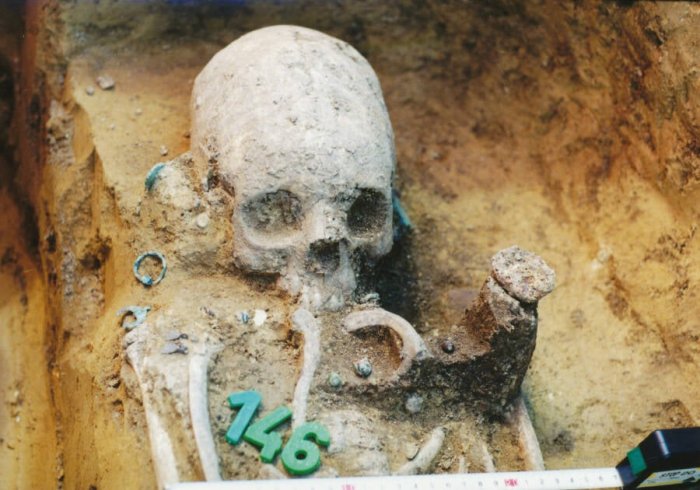Jan Bartek – AncientPages.com – Scientists have examined human remains from 96 graves at the Mözs-Icsei dulo cemetery in Hungary, unveiling crucial insights into the fall of Rome and the significant population shifts in western Hungary.
Grave 43 contained the remains of a young girl whose skull had been artificially elongated, a practice observed in certain ancient cultures. Accompanying her burial were several personal items, including a necklace, earrings, a comb, and glass beads. Credit: Wosinsky Mór Museum, Szekszárd, Hungary
The decline of Roman rule brought about political instability and gave rise to various ‘Barbarian’ powers. While historical records mention these groups, little is known about how these changes impacted daily life during the 5th century AD. Did late Roman traditions endure? Did new customs arise? Or did they blend into unique cultural expressions? The Carpathian Basin (Hungary) is ideal for exploring these historical transformations.
In a groundbreaking study led by Corina Knipper from Germany’s Curt-Engelhorn-Center for Archaeometry, researchers employed modern isotope analysis and biological anthropology methods to reveal that the Mözs-Icsei dulo cemetery contains Central Europe’s largest collection of purposefully elongated skulls—51 in total. This discovery allows historians to trace population history during Rome’s collapse when hostile tribes encroached on its borders.
The tombs of the local people can be identified by their construction using bricks, a practice influenced by Roman customs. This architectural choice reflects the cultural exchange and adaptation during that period. Credit: PLOS ONE/Corina Knipper Et al.
Knippers, who worked with scientists from Eötvös Loránd University, found that bandage wrappings shaped these skulls. In the 5th century, as the Romans abandoned Pannonia (modern-day Western Hungary) due to Hun invasions, new foreign groups regularly arrived seeking protection, sparking a period of profound cultural transformation.
As Rome fell, conflicts with barbarian neighbors intensified over centuries, marked by rebellions and diseases. Yet Knipper’s findings at Mözs-Icsei-dülö provide remarkable clarity on this era’s changes. Initial archaeological surveys combined with isotope analysis revealed a diverse community comprising different ages and groups.
One group was identified as original founders with Roman-style brick-lined graves; another foreign group shared similar isotopic backgrounds suggesting recent arrival alongside locals. This second group likely introduced grave goods traditions and purposeful skull elongation practices—leading researchers to identify a distinct third group blending Roman and foreign customs buried there too.
This skull is from an adult woman who underwent cranial binding during childhood. This practice resulted in the elongation of the braincase and caused depressions in the bone structure. Credit: PLOS ONE/Corina Knipper Et al.
The team discovered 51 uniquely shaped skulls across all ages and genders with depressions from bandage wrappings—a tradition seen worldwide, including Austria, Romania, Serbia, and even the Americas or Africa! Researchers generally agree that it likely signified high society status differentiation among social tiers, which was prevalent globally.
See also: More Archaeology News
“Placed into the historical narrative, this could be understood as the emergence of a Roman-‘Barbarian’ Mischkultur (mixed culture) in which Romanized ‘Barbarians’ and ‘barbarized’ late Roman population groups were indistinguishable,” the researchers conclude in their study.
The study was published in the journal PLOS ONE
Written by Jan Bartek – AncientPages.com Staff Writer




